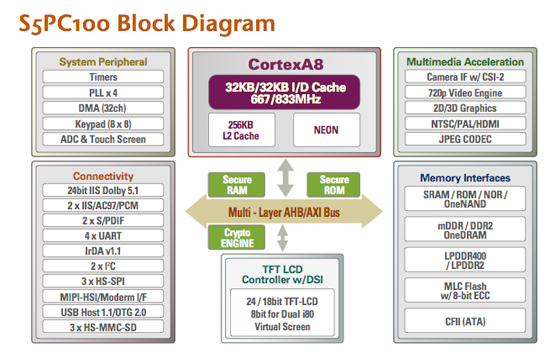The iPhone 3GS Hardware Exposed & Analyzed
by Anand Lal Shimpi on June 10, 2009 12:00 AM EST- Posted in
- Smartphones
- Mobile
Enter the ARM Cortex A8
This past weekend Palm introduced its highly anticipated Pre. While I’m still working on my review of the Pre, I can say that it’s the closest thing to an iPhone since Apple first unveiled the product two summers ago. In many ways the Pre is lacking in areas that the iPhone has honestly perfected, but in others the Pre easily surpasses Apple’s best.
One such area is raw performance. While both the iPhone and iPhone 3G use the same old CPU/GPU, the Pre uses TI’s OMAP 3430 processor. The 3430, like the SoC Apple uses, has both a CPU and GPU on the same package. Instead of the ARM11 and the PowerVR MBX-Lite however, the OMAP 3430 uses an ARM Cortex A8 core and a PowerVR SGX GPU. Both are significant improvements over what was in the original iPhone.
Thankfully, Apple fans don’t have to be outclassed for long - the newly announced iPhone 3GS uses a comparable CPU/GPU pair.
Although unannounced, the iPhone 3GS uses (again) a Samsung SoC but this time instead of the ARM11 + MBX-Lite combo it’s got a Cortex A8 and PowerVR SGX; just like the Pre.

A derivative of this is what you'll find in the iPhone 3GS
If the ARM11 is like a modern day 486 with a very high clock speed, the Cortex A8 is like a modern day Pentium. The A8 lengthens the integer pipeline to 13 stages, enabling its 600MHz clock speed (what I’m hearing the 3GS runs at). The Cortex A8 also widens the processor; the chip is now a two-issue in-order core, capable of fetching, decoding and executing two RISC instructions in parallel.
The ARM11 processor in the iPhone/iPhone 3G has a basic vector floating point unit, but the A8 adds a much more advanced SIMD engine called NEON. The A8 also has twice as many double precision FP registers as the ARM11. The addition of NEON and the improved vector FPU in the A8 makes the processor much less like the original Pentium and much more like Intel’s Atom. Granted, Atom is significantly faster than the A8, but it also draws much more power.
Caches also get a significant improvement. I believe Apple will be using a derivative of Samsung’s S5PC100, which has a 32KB/32KB L1 cache (I/D, we may see a 16KB/16KB config instead) and a 256KB L2 cache. The L2 cache, as you’ll remember from the first section, is a new addition to the A8; the ARM11 core didn’t have an L2.
| iPhone 3G (ARM11) | iPhone 3GS (ARM Cortex A8) | |
| Manufacturing Process | 90nm | 65nm |
| Architecture | In-Order | In-Order |
| Issue Width | 1-issue | 2-issue |
| Pipeline Depth | 8-stage | 13-stage |
| Clock Speed | 412MHz | 600MHz |
| L1 Cache Size | 16KB I-Cache + 16KB D-Cache | 32KB I-Cache + 32KB D-Cache |
| L2 Cache Size | N/A | 256KB |
The combination of higher clock speeds, more cache and a dual-issue front end results in a much faster processor. Apple claims the real world performance of the iPhone 3GS can be up to 2x faster than the iPhone 3G, and I believe that’s quite feasible.

The new SoC is built on a 65nm manufacturing process, down from 90nm in the original hardware. However, power consumption should still be higher for the new SoC compared to the old one. ARM’s own site lists ~0.25mW per MHz for the ARM11 core but < 0.59mW per MHz for the A8. That’s for a 650MHz low power A8 core and I’m expecting 600MHz for the 3GS, that’s at most 3x the power consumption of the CPU in the original iPhone. So how can Apple promise better battery life?
The thing about these comparisons is that they don’t show the full picture. With the same battery capacity, running at full speed, the new iPhone 3GS would run out of juice faster than the existing iPhone 3G. But that’s rarely how people use their phones. Chances are that you’ll perform a few tasks before putting the phone back to sleep, and what matters then is how quickly you can complete those tasks.
Just under nine years ago Intel talked about a technology called Quick Start. Let me quote from our IDF 2000 Day 2 coverage (wow, that was a while ago):
“"Intel has figured out that it is best to use full CPU power for a split second to finish a task and then put the CPU to idle as this conserves battery life the best. Although one may suspect that when running complex operations the CPU would not have time to go idle, this is not the case. To illustrate this point, Intel used an example of DVD playback. Very stressful on the system as a whole, Intel's quick start technology allows the CPU to "hurry up" and perform the DVD decoding operations and then go idle until the frame is displayed to screen and the next scene needs to be calculated. This saves battery life because, although the system may require 3 watts or so to "hurry up", the power consumption goes down near .25 watts when idle. By averaging these two numbers, one can quickly see how quick start can extend battery life."”
The A8’s power consumption has to be well under that 3x max I quoted above, and the iPhone 3GS needs to be more than just 2x faster at executing instructions, but if possible then it’s quite feasible for the faster A8 to draw more instantaneous power but draw less power on average than the ARM11 core in the original iPhone.










65 Comments
View All Comments
Anand Lal Shimpi - Wednesday, June 10, 2009 - link
In addition to the ARM11 core, I believe the GPU side of tegra does use too much power for something like the iPhone. I can't find detailed specs for NVIDIA's low end Tegra, but Wikipedia lists ~4W for the higher end model - that's simply too much. We need to see values in the mW range.Take care,
Anand
peccavi - Wednesday, June 10, 2009 - link
From what I gathered, Apple is increasing support for iPhone peripherals. Could this allow for a controller / docking cradle for the iPhone? Imagine 4 buttons and a couple of directional pads on either end of the phone in landscape mode. Would make for a great little gaming unit.eburnette - Wednesday, June 10, 2009 - link
One thing that wasn't clear from the article is how certain are you about the information? Is it just speculation at this point until somebody gets one and tears it down?Anand Lal Shimpi - Wednesday, June 10, 2009 - link
I'm very certain. The info comes from sources very close to the licensees for both the CPU and GPU. Without hardware in hand it's impossible to be 100% sure, but what Apple has implied lines up well with what I've been told.The ~2x gains in app performance would only come from a faster processor. Apple's options there are to either use a much higher clocked ARM11 or move to the Cortex A8. You can't get 2x out of a 200MHz speed boost to an ARM11 core, so that leaves the A8.
The graphics side I'm also very sure about, although I can't post why :)
Take care,
Anand
psychobriggsy - Wednesday, June 10, 2009 - link
Thanks for confirming the rumours.I think you should point out that the CPU and GPU are actually on the same die, indeed everything apart from the RAM will be on that die. Some parts of the article imply that the CPU and GPU simply share the package, but could be separate dies.
A little sad that the GPU is the SGX520 - the lowest end, but it's still so much better than the MBX it doesn't matter. Shame you can't snaffle a die shot from Samsung ;) maybe the graphics are by comparison quite large, even considering the A8 with L2 cache.
The crypto co-processor that's been added is certainly being used, as hardware crypto was mentioned in the keynote. That will aid iPhone SSL web browsing speed I'd hope.
Also the A9 is out-of-order, so comparable to a Nano, as the A8 is comparable to Atom and the ARM11 is comparable to a very fast 486.
Simon F - Wednesday, June 10, 2009 - link
[quote]Paired with this CPU is a PowerVR MBX-Lite GPU core. This GPU, like the CPU, is built on a 90nm process and is quite simple. The GPU does support hardware transform and lighting but it’s fully fixed function, think of it as a DirectX 6/7 class GPU (Riva TNT2/GeForce 256).[/quote]This is not strictly correct. IIRC the MBX model in the iPhone has a programmable vertex shader that exceeds DX8. The pixel pipeline, though, is fixed function. Having said this, I'm not sure if the programmable aspects of the vertex shader are exposed in the iPhone interface.
faxon - Wednesday, June 10, 2009 - link
i have by and large stayed away from apple my entire life, but given their recent innovation on the consumer devices front and their virtual monopoly on the high capacity music players market with the ipod, i have been keeping them on my radar none the less. when a family member picked up an iphone3G when we switched to AT&T for our wireless service, i was actually rather impressed at simply how much better it was than the blackjack 2 i picked up, at just about everything. the only complaint i had was in its texting performance, but with a cloned SIM card i could get around that simply by pulling out my blackjack 2 instead. I have been looking at getting an iphone since i use my phone for mobile browsing excessively, and even using opera the blackjack 2 doesnt come close in ease of use compared to the old iphone on edge. with the new 3Gs also supporting picture texting (a requirement of my GF) i may just look into this if i get the promotion im gaming for by the end of the summer.sxr7171 - Wednesday, June 10, 2009 - link
I avoided the iPhone for so long and I even bought one to jailbreak and play with, but it wasn't until OS 3.0 that it became my daily phone. The Exchange support on it beats most other smartphones.strikeback03 - Wednesday, June 10, 2009 - link
I'd say high capacity music players are the only segment of mp3 players where the Ipods are not dominant. The only high capacity models are the classic/video ones, which don't seem to be that popular and don't appear to have been upgraded nearly as recently as the touch and nano.Dennis Travis - Wednesday, June 10, 2009 - link
Anand, thanks so much for your preview. I can't wait for your review after you get a hold of the phone. I am really interested in battery life. During the keynote I thought they said something about a new battery and that was why more battery life. I guess we will soon know for sure.Thanks again!